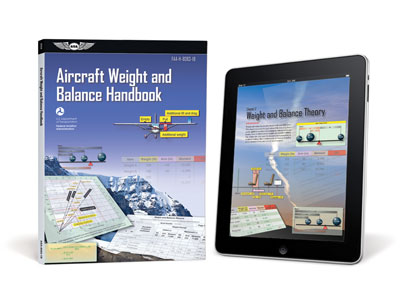Time to update your aviation library! ASA has just taken delivery of newly published editions of the Pilot’s Handbook of Aeronautical Knowledge (FAA-H-8083-25) and Aircraft Weight and Balance Handbook (FAA-H-8083-1). Both FAA Handbooks have been revised and edited to include more relevant and meaningful information with regards to today’s flight environment.
The Pilot’s Handbook of Aeronautical Knowledge also referred to as the PHAK is the go-to reference for pilots of all levels covering a broad range of aeronautical knowledge areas. This 2016 edition reflects the latest aviation industry procedures, equipment, techniques, regulations, including unmanned aircraft systems (UAS), and is a key reference in the FAA Airman Certification Standards (ACS). Complete with chapter summaries and illustrated throughout with detailed, full-color drawings and photographs, this handbook functions like an “aviation encyclopedia” to expand pilots’ knowledge of their field.
The Aircraft Weight and Balance Handbook is another excellent reference to have within arm’s reach. This 2016 edition reflects the latest aviation industry procedures, equipment, techniques, regulations, and, like the PHAK, is a key reference in the FAA Airman Certification Standards (ACS). Illustrated throughout with detailed, full-color drawings, and includes a glossary and index.
If you are not yet fully familiar with the ACS document, each task contains a references section. Many of the references include either one or both of the above handbooks. As a student, if you do not fully understand the elements outlined within the ACS task, refer to the references section to determine where to learn more about those specific elements.
FAA Handbooks are some of the best reference documents available and a valuable tool to have at your disposal. Although as an instructor I like to caution both students and instructors in the use of FAA Handbooks. It is important to understand the difference between a handbook versus a textbook or manual. A handbook like the PHAK is a topically organized book of references on a certain field of knowledge, in this case aeronautical knowledge. As the saying goes it’s like drinking from a firehose, an overwhelming amount of information coming at you all at once. A textbook (or manual) differs in the sense that it is put together in a way where it becomes a formal manual of instruction in a specific subject. Simply put textbooks follow an outline that is geared to teach the information in smaller chunks or building blocks. Examples of student pilot textbooks include the Pilot’s Manual: Ground School, The Complete Private Pilot by Bob Gardner, and The Student Pilot’s Flight Manual, by William Kershner.
So what is the proper way to use FAA Handbooks as a student or instructor?
Initial instruction and learning should be accomplished through a structured textbook following an approved syllabus of study. Once the initial learning takes place it can be expanded upon with the use of the many handbooks published by the FAA. These handbooks often will provide greater detail into particular subject matter, making for much safer competent pilots.






